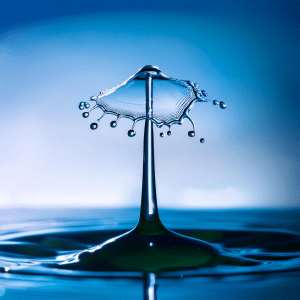Formaldehyde, Like All Other Chemicals, Is Not Smart. It Is As Clueless As A Goldfish In A Library. It Will Keep Crosslinking With Proteins Until It's All Gone, Whether It's In A Deceased Human Or Somewhere Else. So, When I Am Discussing The Merits Of Different Arterial Fluids With People, I Rarely Talk About Formaldehyde And Instead I Talk About Other Components That Help It Find Direction.
As humans, we often like to personify things, giving them thoughts and actions of their own, and expecting them to behave in the ways we have envisioned. As embalmers, some of us give these characteristics to formaldehyde more often than we should. I certainly have been guilty of picturing my arterial solution as a superhero disinfecting and preserving, swiftly casting obstacles aside while I watch patiently for firming to occur. There is a problem with this; formaldehyde, like all other chemicals, is not smart.
During embalming, formaldehyde will only do what nature tells it to; float around aimlessly until it is attacked by nitrogen. In the case of nitrogen found on proteins, that’s what causes the crosslinking and subsequent preservation of a deceased human. There is no conversation when a molecule of formaldehyde runs into a protein to discuss whether crosslinking at that time is appropriate because the protein is in the arm rather than the leg. The vapidity of formaldehyde can be helpful to us though when explaining the use of formaldehyde to the public. For example, a common question is “where does the formaldehyde go after a person is embalmed and does it contaminate the ground water?” The answer to this question is that because embalming is a chemical change, after it is completed, the formaldehyde is gone.
Even the stuff that goes down the drain is going to encounter proteins (we send it down there with blood, which is chock full of proteins) and will likely be neutralized before it leaves the funeral home property. Why? Because formaldehyde is as clueless as a goldfish in a library. It will keep crosslinking the proteins until it’s all gone, whether it’s in a deceased human or somewhere else. So, when I am discussing the merits of different arterial fluids with people, I rarely talk about formaldehyde, instead I talk about the other components that help it find direction. Let’s look at some of those helper chemicals and what you might look for when you are reading a Safety Data Sheet (SDS) (I know, boring) or talking to your fluid salesperson (also boring). You are certainly familiar with the general categories of modifying chemicals, but let’s look at what they do to negate formaldehyde’s doltish ways.
Buffers
Examples: EDTA, borates, triethanolamine
No doubt you noticed that EDTA and borates appear again. You might recognize that a 16 oz bottle of arterial fluid is a finite space, so it makes sense to have chemicals that do double duty. You also probably know that buffers balance pH. To me, this is probably the most overlooked characteristic of an arterial fluid from the embalmer’s perspective, because I believe that chemicals companies do a good job of including buffers in their arterial fluids. Why? Because they know that formaldehyde will do an impression of Side Show Bob stepping on a rake without it. Postmortem pH has a big effect on formaldehyde, as it has a very small window in which it is effective. Recall from mortuary school the order these body compounds break down; carbohydrates, soft proteins, oils, hard proteins. It’s these first two that we are the most concerned about because carbohydrates create an acidic pH and soft proteins create an alkaline one. Under acidic conditions, formaldehyde will do very little and under alkaline conditions, it will act like an dog at a dog park greeting all its friends. But why so choosey? Remember another name for formaldehyde is “formic acid” and another acid won’t give the balance formaldehyde seeks, making it less effective. On the other hand, the ammonia compounds from the proteins create an alkaline environment for formaldehyde to react. Lack of buffers would mean that our witless preservative would never make it to the fingers and toes. In fact, one of the reasons you might not see firming in these areas despite other signs of positive distribution is because the formaldehyde might have gotten distracted along the way.
Anticoagulants
Examples: EDTA, borates
Now we all know that anticoagulants break up blood clots. But how does that help formaldehyde? Perhaps when we think of coagulants, we picture the trophy sized clots we are so proud to display, or maybe even the little bits and flecks of dried blood that we see in our drainage. However, we must think even smaller than that. Clots can form in the capillary beds at a microscopic level and prevent even diffusion of formaldehyde.
Two things can then happen—
1. The formaldehyde just floats on by or;
2. It crosslinks with the blood instead of the body tissues. Remember, formaldehyde doesn’t stop because it thinks it should, it is adrift like a feather in the wind. This is why people advocate for pre-injection; it opens the door for our gormless preservative. Mechanical techniques like massage help, but it is the chemicals that one needs to anticoagulate at the smallest levels.

Humectants
Examples: Lanolin, Silicon
Now it’s no secret that the function of humectants is to help retain moisture, because due to the crosslinking reaction, water is lost and needs to be retained. Again, formaldehyde doesn’t know it’s not supposed to do that. However, humectants can be more than that helpful than that, since humectants draw water into tissue, they can take formaldehyde along with it, helping it to diffuse into the tissues better.

Surfactants
Examples: Silicone, triethanolamine, soap
This is an important one. The term “hydrogen bonding” is probably one you’ve heard before, a quick reminder that this is what happens when one of the hydrogen atoms on a water molecule connects with the atom of oxygen on another water molecule creating a lattice work. Hydrogen bonding is what is known as a “static” bond, so it’s not as strong as a covalent or ionic bond, which is good for us because that means it’s easily broken up. This phenomenon can happen in many places we see a hydrogen atom and an oxygen atom, not just water molecules. We can observe hydrogen bonding between water molecules on the macro scale when we see water surface tension, but it also happens on the outside of cells and in capillary beds. This also happens to create a barrier for formaldehyde to run into like Wile E. Coyote running into a fake wall. By using fluids that contain surfactants, we can bolster our diffusion, as well as ensure better retention of preservation in the tissues.
See? There’s a reason we learned about this stuff in mortuary school, it wasn’t just to give the teachers something else to test us on. Having a better understanding of all the chemicals makes us better case analysts and consumers. It also helps us communicate with one another as well; I talk about one fluid, and you talk about another fluid for the same type of case, taking a moment to see what they have in common can only help us become better embalmers. So next time you are talking to someone about fluid, don’t ask what index it is, ask “what is helping our little buddy formaldehyde.”
The Foolish Nature of Formaldehyde